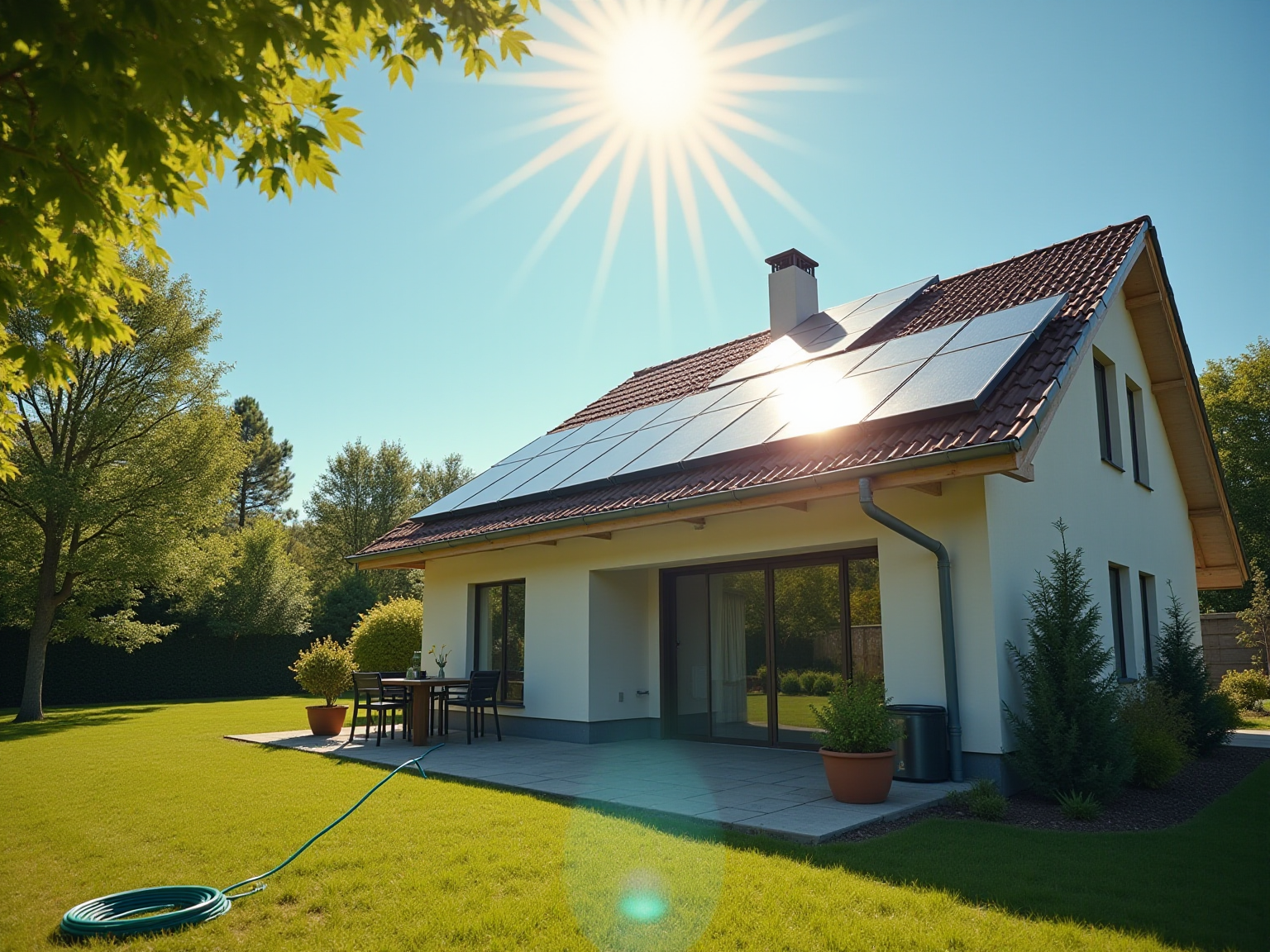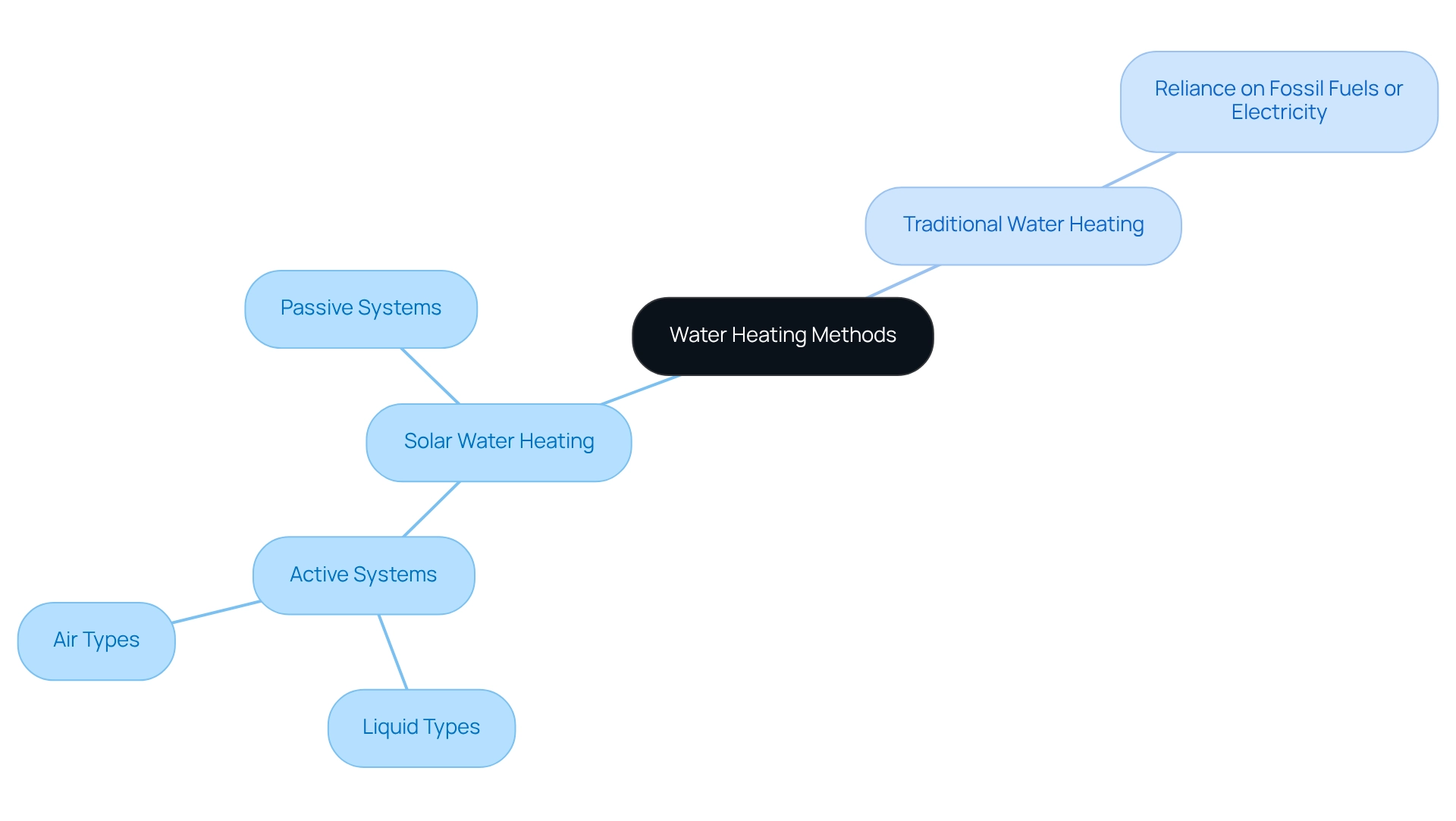Overview
We understand that rising energy bills can be a significant concern for homeowners. In exploring sustainable solutions, it’s essential to consider the efficiency and costs of solar water heating systems compared to traditional heating methods. While the initial installation costs for solar systems may seem higher, they present an opportunity for substantial long-term savings on energy bills. Moreover, solar technology offers a lower environmental impact, making it a more sustainable choice, particularly for those living in sunny regions.
Imagine the peace of mind that comes from knowing you are making a positive impact on the environment while also gaining energy independence. By choosing solar, you are not just investing in your home; you are also investing in a greener future for our planet. Together, we can take steps towards a more sustainable lifestyle that benefits both your household and the environment.
If you have questions about how solar water heating can work for you, we are here to support you every step of the way. Let’s work towards a brighter, more sustainable future together.
Introduction
As we navigate a world increasingly focused on sustainable energy solutions, many homeowners find themselves concerned about rising energy bills and the environmental impact of traditional systems. It’s common to feel overwhelmed by the choices available, but solar water heating systems offer a compassionate alternative. By harnessing the sun’s energy, these systems provide a cleaner and more efficient solution compared to conventional methods that rely on fossil fuels.
Imagine the relief of seeing significant savings on your energy bills while also reducing your carbon footprint. This transition to solar technology not only supports your financial well-being but also contributes to a healthier planet. In this article, we’ll explore the mechanics of solar water heating, compare installation costs, and highlight the environmental advantages.
Together, we can empower you to make informed choices that lead to a greener future, ensuring that you feel supported every step of the way.
Understanding Solar Water Heating and Traditional Water Heating
We understand that rising energy bills can be a significant concern for homeowners. offer a nurturing solution by employing collectors that capture sunlight and transform it into warmth, which is then utilized in solar to heat water. This method shines particularly bright in sunny regions like California, where both active and passive solar energy solutions can truly thrive.
Active setups, utilizing pumps and controls to circulate heat transfer fluids, can be categorized into:
- Liquid types—using water or antifreeze
- Air types that circulate warmed air through ducts, including those that employ solar to heat water
These systems are ideal for homes seeking reliable warmth and comfort.
In contrast, passive approaches rely on thoughtful building design to enhance heat absorption without mechanical devices, creating an inviting atmosphere naturally. Traditional methods for heating liquids, such as electric or gas heaters, often depend on fossil fuels or electricity, whereas using solar to heat water can lower operational expenses and reduce the environmental footprint. Recognizing these distinctions is crucial for homeowners contemplating a transition to photovoltaic technology. It highlights the potential for substantial energy savings, reduced greenhouse gas emissions, and lasting sustainability benefits associated with these installations.
For instance, many homeowners in California have joyfully reported reductions of up to 50% in their energy costs after embracing thermal systems. By thoughtfully evaluating their specific needs, regional weather conditions, and budget, homeowners can make informed decisions that not only enhance their energy efficiency but also contribute to a more sustainable future. Together, let’s work towards a brighter, more energy-independent tomorrow.
How Solar Water Heating and Traditional Systems Work
Are you feeling overwhelmed by rising energy bills? You’re not alone. Many homeowners share your concerns, and it’s completely natural to seek solutions that can alleviate this burden.
Solar heating setups, which typically consist of solar collectors, a storage tank, and a circulation mechanism, utilize solar to heat water as a sustainable alternative. These collectors use solar to heat water by capturing sunlight and converting it into heat, which raises the temperature of the liquid in the storage tank. You have the option of an active setup, which uses pumps to circulate the liquid, or a passive one that relies on natural convection. In contrast, conventional heaters often depend on electric resistance or gas burners to heat the liquid in a tank. While these traditional systems can deliver hot water on demand, they often lead to higher energy costs and contribute to greenhouse gas emissions. Remarkably, the efficiency of photovoltaic systems can reach up to 80%, significantly outperforming many conventional installations, especially in sunny climates.
At Powercore Electric, we understand that the installation process can seem daunting. Our dedicated team is here to ensure a seamless experience for you. We start with professional racking and mounting, securely attaching the necessary hardware to your roof for a sturdy foundation. Next, we carefully position each panel to maximize sunlight exposure, ensuring you receive optimal energy output. Our skilled technicians connect using top-quality wiring methods, integrating the system with your home’s electrical panel or optional battery storage. This comprehensive approach not only boosts efficiency but also reduces your reliance on the grid, paving the way for significant energy savings.
As continue to rise across California, homeowners like you can embrace the benefits of clean, renewable energy while actively reducing your carbon footprint. Together, we can work towards a more sustainable future. If you’re ready to explore how solar energy can transform your home and your energy bills, we invite you to reach out to us. Let’s take this important step towards energy independence together.
Cost Analysis: Installation, Maintenance, and Savings
We understand that rising energy bills can be a significant concern for homeowners. The primary setup expense of thermal energy units generally varies from $3,000 to $9,000, influenced by factors like type and size. While this investment may seem higher than conventional solutions, which typically range from $1,000 to $3,000, it’s important to note that photovoltaic installations often benefit from federal and state tax credits, effectively reducing the net cost.
Imagine the relief of a straightforward payback duration for installations that use solar to heat water, with subsidies that can shorten the duration to just 2.8–3.4 years. This emphasizes the monetary advantages of such an investment. Additionally, maintenance expenses for thermal systems are typically lower due to fewer moving components and less frequent servicing. Homeowners can expect substantial savings on energy expenses, with many seeing decreases of 50% or more compared to traditional heating methods.
This potential for long-term savings, combined with the rising cost-efficiency of thermal systems—especially considering —positions solutions such as solar to heat water as an attractive choice for environmentally conscious homeowners. Many case studies demonstrate the efficacy of sunlight-based technologies in various home environments. For instance, a home in Southern California experienced a remarkable reduction in energy costs, exceeding 70%, after installing a renewable energy solution. This setup not only provided significant savings but also contributed to their sustainability efforts by reducing their carbon footprint.
If you reside in a cloudy or cool region, your hot water heater installer may suggest an active device with a backup power source. It’s common to feel uncertain about solar energy in different climates, but the yearly average solar fraction of 71% showcases to heat water is, especially during the summer season. Together, we can explore these solutions that not only save you money but also support a healthier planet.
Environmental Impact: Sustainability of Solar vs. Traditional Heating
We understand that many homeowners are concerned about rising energy bills and the environmental impact of their choices. Solar thermal systems present a sustainable solution by utilizing solar to heat water, harnessing renewable energy from the sun and reducing dependence on fossil fuels. This transition not only lowers greenhouse gas emissions but also helps to decrease air pollution, addressing your concerns for a healthier planet. Traditional water heating methods, particularly those powered by natural gas or electricity from non-renewable sources, contribute to a higher carbon footprint. By embracing renewable energy, you can significantly lessen your environmental impact, aligning with global efforts to combat climate change.
Moreover, numerous areas provide incentives for photovoltaic installations, including government initiatives that encourage renewable energy adoption. These incentives can enhance the economic advantages for homeowners like you. Furthermore, the incorporation of battery alternatives enables effective energy storage, optimizing the utilization of sunlight. As you explore these sustainable options, assessing energy service providers becomes essential to finding the best value in energy solutions, ensuring long-term sustainability and efficiency.
It’s common to feel overwhelmed by the choices available, but considering options like can further enhance energy efficiency in your home. Together, let’s work towards a brighter, more sustainable future by assessing all available solar energy solutions. Your journey towards energy independence and environmental stewardship begins with informed choices, and we are here to support you every step of the way.
Conclusion
We understand that many homeowners are concerned about rising energy bills and are searching for effective solutions. Transitioning to solar water heating systems not only presents an opportunity to significantly reduce these costs but also contributes to a more sustainable future for our planet. By harnessing the sun’s energy through solar collectors, these systems provide a clean and efficient alternative to traditional methods that often rely on fossil fuels. Impressively, many solar water heating systems achieve efficiency rates of up to 80%, particularly in sunny regions, offering a remarkable solution to energy concerns.
It’s common to feel hesitant about the initial investment, but the financial implications of switching to solar are compelling. While installation costs may be higher than those of traditional systems, the long-term savings on energy bills, alongside available tax incentives, can lead to a rapid return on investment. Homeowners can anticipate a payback period as short as 2.8 years, making solar water heating not just an environmentally responsible choice, but a financially savvy one as well.
Moreover, the environmental impact of adopting solar technology is significant. By reducing our reliance on non-renewable energy sources, solar water heating systems help lower greenhouse gas emissions and decrease air pollution. This shift aligns beautifully with global efforts to combat climate change, making it a crucial step for eco-conscious homeowners who care deeply about the world we leave behind.
In summary, investing in solar water heating systems is a powerful way to achieve both financial savings and environmental sustainability. As we collectively move towards cleaner energy solutions, embracing solar technology not only benefits individual households but also supports the broader goal of creating a healthier planet for future generations. Together, we can make a difference—let’s work towards a sustainable future that benefits us all.



